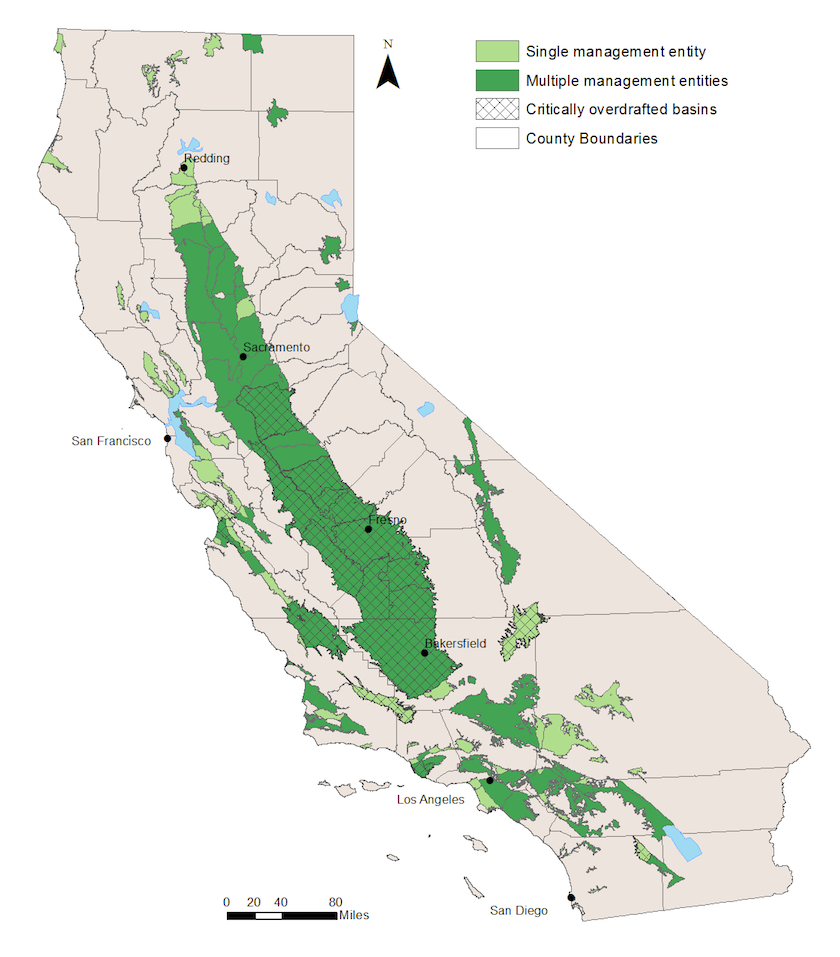October 19, 2017 | Water in the West | Insights

Groundwater well in Yolo County.
Imagine trying to fly a plane while it’s still being built. Impossible, right? Yet, this is how one presenter at a recent Groundwater Resources Association meeting described the challenge that lies ahead for many newly formed agencies responsible for managing groundwater basins in California.
For local agencies involved in managing groundwater, the past few years haven’t been easy ones. But not just because the state was gripped by extreme drought. A new state law, the Sustainable Groundwater Management Act (SGMA) of 2014, required local agencies, in consultation with groundwater users, to form Groundwater Sustainability Agencies (GSAs) before June 30, 2017. Otherwise, the state could step in.
The incentive to avoid state intervention turned out to be a strong one. As of July 1, over 250 GSAs had formed, and only very small areas of basins where GSAs were required were left without one. As described in a recently released research brief, about half of high and medium priority basins (where most of the law’s requirements apply) are now managed by a single entity. The other half – representing a far greater land area – have anywhere from 2 to 22 entities in charge.
Forming GSAs was a heavy lift in many basins where coordination to manage groundwater has previously been limited. Yet, the upcoming task of developing Groundwater Sustainability Plans (GSPs) may be even harder. In basins with multiple GSAs, it will require reaching agreement on highly technical and often contentious issues such as water budgets and estimates of sustainable yield. SGMA also sets a high standard for public involvement in the process, requiring that GSAs “encourage the active involvement of diverse social, cultural, and economic elements of the population.”
The analogy of “building a plane while flying it” is an apt one, particularly in multi-GSA basins. Flying a plane is a highly complex and technical endeavor, and involves careful planning to ensure that passengers arrive safely and on time at a chosen destination. Similarly, developing a GSP involves detailed analyses to establish a sustainability goal and measurable objectives (the destination), and specific management strategies (the flight plan) to get there by 2042 or 2040, depending on the basin. Flying also requires advanced equipment to gather and analyze data while in flight, and well-defined protocols for communication and collaboration among flight crew members. In basins with multiple GSAs, the cockpit is pretty full. Yet, many GSAs have yet to develop mechanisms for how they will work together on key tasks such as monitoring, data management, defining a water budget and sustainable yield, and more. In other words, they are still assembling the plane, and learning how to fly it.
In light of this, it would seem most efficient to have a single GSA piloting each basin’s “flight” to sustainability. Originally, SGMA’s drafters contemplated requiring this. However, in response to concerns that this would not provide local agencies with adequate flexibility, the law ultimately allowed for the formation of multiple GSAs, as long as they work together in managing the groundwater basin. As detailed in the GSP regulations, multiple GSAs may collaborate to write a single GSP, or they may submit multiple GSPs that are based upon the same “data and methodologies,” including a common water budget and basinwide sustainable yield. In other words, all GSAs in a basin need to have the same flight plan.
There are a number of reasons why stakeholders in some basins chose to form multiple GSAs rather than just one. As documented in a December 2016 report by authors from Stanford and the Center for Collaborative Policy at California State University, Sacramento, factors influencing this decision included the size of groundwater basins, the degree of heterogeneity of hydrologic conditions, and concerns regarding autonomy and representation, among others.
Basins managed by multiple entities now account for about 80 percent of the area covered by high and medium priority basins. This includes 16 out of the 21 basins designated as “critically overdrafted,” which face tough challenges to reach sustainability. They also have less time. The GSAs in critically overdrafted basins must submit their GSPs to the state by 2020 (rather than 2022), and must be sustainably managed by 2040 (rather than 2042).

Coverage of high and medium priority basins by single or multiple management entities. These entities may take the form of 1) one or more GSAs; 2) an alternative plan; 3) an adjudication; 4) an "unmanaged" area; or 5) a combination thereof. Only high and medium priority basins are shown here.
In some multi-GSA basins, basinwide dialogue took place during the GSA formation process, and mechanisms for coordination were established prior to June 30. These range from relatively informal structures, such as an agreement for designated members of each GSA’s board to meet regularly, to more formal arrangements such as a joint powers agreement (JPA) involving multiple GSAs. While GSAs in these basins still need to choose a destination and develop a flight plan, they do have a functional plane (even if it needs some tinkering).
In other basins, however, steps toward basinwide coordination are only just beginning, even as the GSP development process gets underway. These GSAs still need to establish routines for consulting one another, create platforms for sharing data, and define protocols for making decisions and resolving conflicts. It is critical to start developing these. Investments made now in “building the plane” are likely to have significant payoffs during the long – and potentially bumpy – flight ahead.
With thanks to Dave Ceppos at the Center for Collaborative Policy for the analogy that inspired this piece.

![[Woods Logo]](/sites/default/files/logos/footer-logo-woods.png)
![[Bill Lane Center Logo]](/sites/default/files/logos/footer-logo-billlane.png)